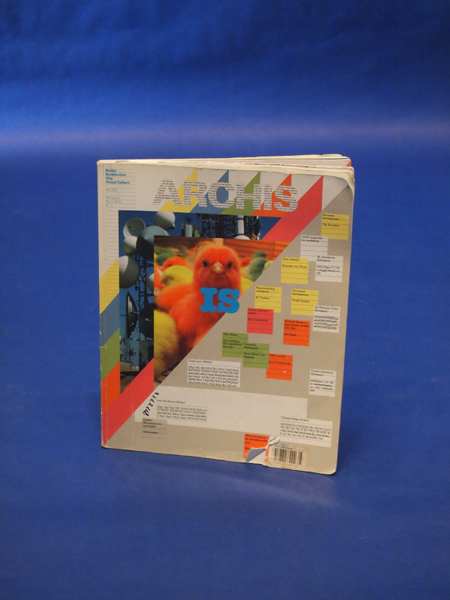![]() body | color | collections | commodity | cube | document | fabric | fetish | gender | glass | home | identity | living | machine | metal | minimal | mobility | narrative | olfactory | organic |
body | color | collections | commodity | cube | document | fabric | fetish | gender | glass | home | identity | living | machine | metal | minimal | mobility | narrative | olfactory | organic |
![]() pain | paper | plastic | plugs | power | protective | rectangular | ritual | round | sound | souvenir | spiritual | style | text-based | time | tool | touch | uniform | value | visual | warm | wood
pain | paper | plastic | plugs | power | protective | rectangular | ritual | round | sound | souvenir | spiritual | style | text-based | time | tool | touch | uniform | value | visual | warm | wood
| Magazine: Archis #3 2011 | |||
Narrative: Archis #3 2011 Text for Archis #3 was typeset and the mechanical copy of the manuscript was sent to a printer. The vendor then photographed the pages to produce page negatives. Next, negatives were stripped by hand onto large flat sheets known as 'goldenrods,' and the goldenrods were exposed with ultraviolet light. This resulted in 'blueprints," a positive reproduction of the book that is then checked for accuracy. Color printing inks are made primarily with linseed oil, soybean oil, or a heavy petroleum distillate as the solvent combined with organic pigments. The pigments are made up of salts of multiring nitrogen-containing compounds (dyes), such as yellow lake, peacock blue, phthalocyanine green, and diarylide orange. Inorganic pigments also are used in printing inks to a lesser extent. Some examples are chrome green (Cr2O3), Prussian blue (Fe4[Fe(CN)6]3), cadmium yellow (CdS), and molybdate orange (a mix of lead chromate, molybdate, and sulfate). Black ink is made using carbon black. White pigments, such as titanium dioxide, are used either by themselves or to adjust characteristics of color inks. Inks also contain additives such as waxes, lubricants, surfactants, and drying agents to aid printing and to impart any special characteristics. Printing ink is a $10 billion global industry. The paper was made from pulp obtained by chemical means, known as kraft pulping. Chips of wood were placed in a large, sealed container known as a digester. The digester contained a strongly alkaline solution of sodium hydroxide and sodium sulfide. The mixture was heated to 320-356° F (160-180°C) at a pressure of about 116 pounds per square inch (800 kilopascals). Bleaching removes lignin and involves mixing the pulp with a series of oxidizing chemicals that react with the lignin. After each mixture, the pulp is washed with an alkaline solution that removes the treated lignin. Fillers are added to the pulp. A typical filler is a clay known as kaolin. Other chemicals often added to pulp include starches or gums. Rosin (a substance derived from pine trees) and alum (aluminum sulfate) are often added as sizers, making the paper less absorbent. Pulp is added to water to form slurry in order to make paper with an even density. After the typeset version of the book was reviewed and necessary changes made, it was printed and bound with the cover, resulting in a finished book. The typesetting and printing consists of filming and all subsequent steps are typically done by specialized vendors. Book binding also involves sewing the signatures together, gluing the spine, and inserting lining and trimming the edges. Finally the book is enclosed in a cover. I purchased this magazine at Newsstand on 14th Street for $20, and it turned out to be a key resource for the research I was doing on architectural space and urban code at the time. |
 |
||
![]()
